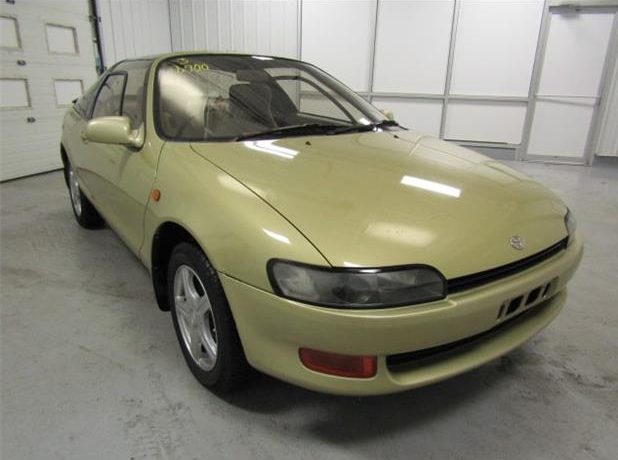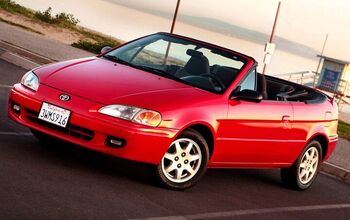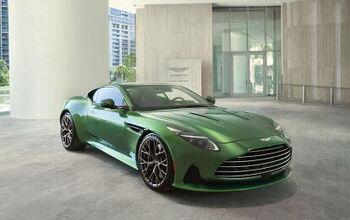Rare Rides: The Paseo-adjacent 1991 Toyota Sera

Only one car combines cheap and cheerful motoring with economical driving and butterfly doors. Fittingly, its Tercel and Paseo siblings were also dredged up in this QOTD post.
It’s the Toyota Sera, from 1991.
Toyota previewed the concept that would become the Sera in 1988, calling it the AXV-II. Radical butterfly doors combined with a roof made mostly of glass for a very slick, eye-catching design. Onlookers were duly pleased when Toyota released the Sera in 1990 in a production format that saw very few changes from the concept.
A four-seat hatchback, the Sera was intended as a downmarket alternative to the popular MR-2. Never intended for sale outside the Japanese market, the Sera was sold only at Toyota’s Corolla Store. Imagine having a store just for Corollas in North America. What a Scion ridiculous idea!
The unique hatchback style was the only one offered on the Sera, and all trim levels used the same engine: a 1.5-liter inline-four from its brother, the Paseo. Toyota did see fit to offer different transmissions to its customers; a four-speed automatic and a five-speed manual were available.
Air conditioning was standard on all Seras, given the extensive use of glass, and this economical hatchback was one of the first vehicles to use projector HiD lamps. The cars were built in phases, and each phase determined the general color schemes available to buyers. Phase I was 1990 and 1991, the period when the majority of Seras (over 12,000) were produced. Phase II spanned 1991 and 1992, and the final Phase III was 1992 through 1995. In total, 18,852 Seras were built. When production ended, there was no official replacement for the Sera. At least the MR-2 would soldier on.
Today’s Rare Ride is a rarer example from Phase II, in light green. With an automatic transmission and in need of some cleaning, Duncan Imports asks $9,998.
[Images: seller]

Interested in lots of cars and their various historical contexts. Started writing articles for TTAC in late 2016, when my first posts were QOTDs. From there I started a few new series like Rare Rides, Buy/Drive/Burn, Abandoned History, and most recently Rare Rides Icons. Operating from a home base in Cincinnati, Ohio, a relative auto journalist dead zone. Many of my articles are prompted by something I'll see on social media that sparks my interest and causes me to research. Finding articles and information from the early days of the internet and beyond that covers the little details lost to time: trim packages, color and wheel choices, interior fabrics. Beyond those, I'm fascinated by automotive industry experiments, both failures and successes. Lately I've taken an interest in AI, and generating "what if" type images for car models long dead. Reincarnating a modern Toyota Paseo, Lincoln Mark IX, or Isuzu Trooper through a text prompt is fun. Fun to post them on Twitter too, and watch people overreact. To that end, the social media I use most is Twitter, @CoreyLewis86. I also contribute pieces for Forbes Wheels and Forbes Home.
More by Corey Lewis
Latest Car Reviews
Read moreLatest Product Reviews
Read moreRecent Comments
- Lorenzo This car would have sold better if there was a kit to put fiberglass toast slices on the roof.
- Lorenzo The Malibu is close to what the 1955 Bel Air was, but 6 inches shorter in height, and 3 inches shorter in wheelbase, the former making it much more difficult to get into or out of. Grandma has to sit in front (groan) and she'll still have trouble getting in and out.The '55s had long options lists, but didn't include a 91 cubic inch four with a turbo, or a continuously variable transmission. Metal and decent fabric were replaced by cheap plastic too. The 1955 price was $1765 base, or $20,600 adjusted for inflation, but could be optioned up to $3,000 +/-, or $36,000, so in the same ballpark.The fuel economy, handling, and reliability are improved, but that's about it. Other than the fact that it means one fewer sedan available, there's no reason to be sorry it's being discontinued. Put the 1955 body on it and it'll sell like hotcakes, though.
- Calrson Fan We are already seeing multiple manufacturers steering away from EVs to Hybrids & PHEVs. Suspect the market will follow. Battery tech isn't anywhere close to where it needs to be for EV's to replace ICE's. Neither is the electrical grid or charging infrastructure. PHEV's still have the drawback that if you can't charge at home your not a potential customer. I've heard stories of people with Volts that never charge them but that's a unique kind of stupidity. If you can't or don't want to charge your PHEV then just get a hybrid.
- AZFelix The last time I missed the Malibu was when one swerved into my lane and I had to brake hard to avoid a collision. 1 out of 5⭐️. Do not recommend.
- 2ACL I won't miss it; it was decent at launch, but in addition to the bad packaging, GM did little to keep it relevant in the segment. I'd prefer that another domestic automaker doesn't just give up on the mainstream sedan, but unlike some of Ford's swan songs, the Malibu made an indifferent case for why they should live.







































Comments
Join the conversation
I like the design. It is different. But if it was sold only in Japan, why are the controls marked with English lettering, not Japanese?
I thought these were banned because of the doors? How do they function in a rollover accident?